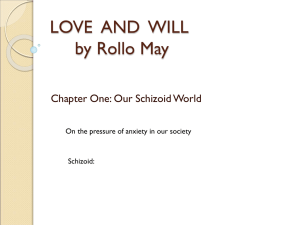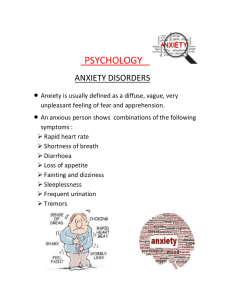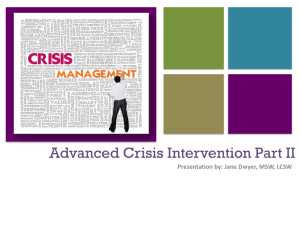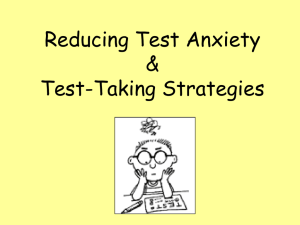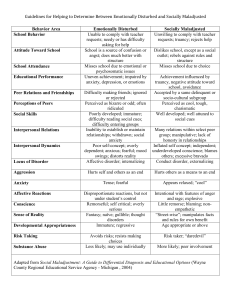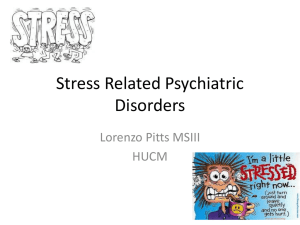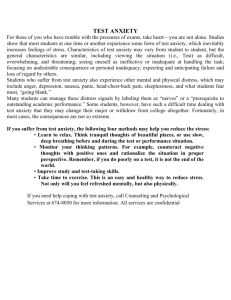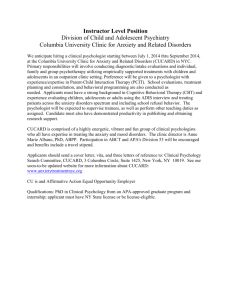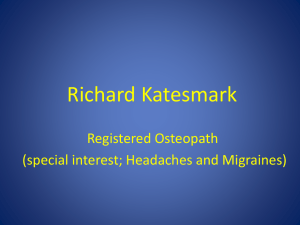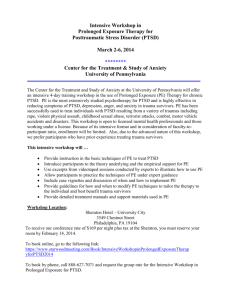Post-Traumatic Stress Disorder
advertisement
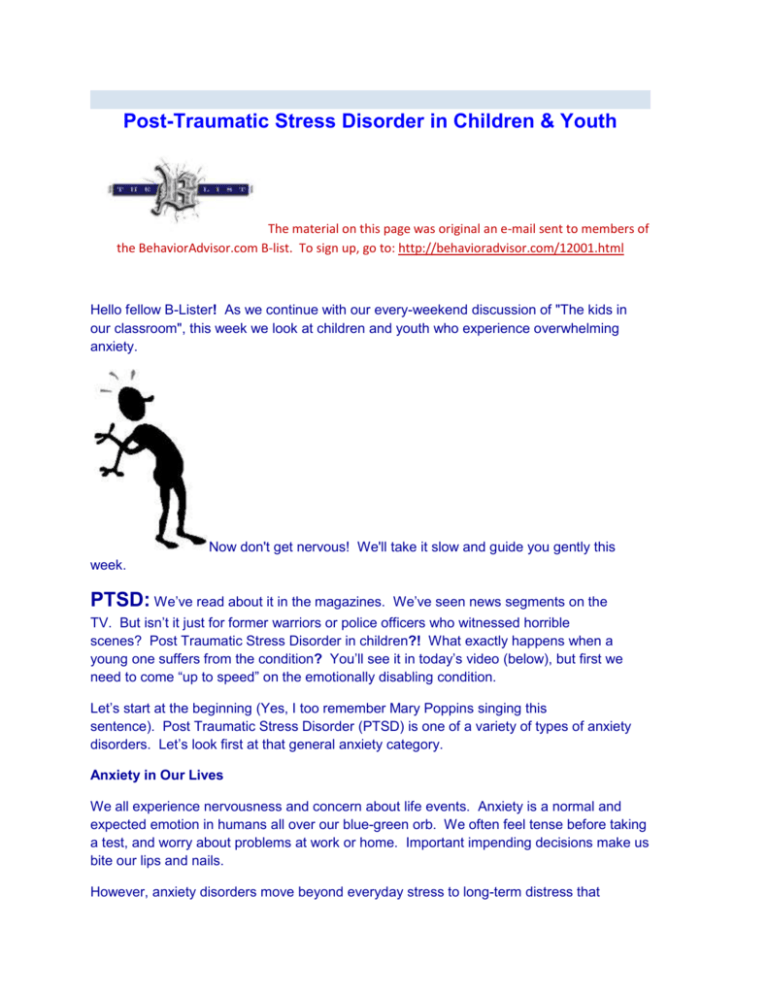
Post-Traumatic Stress Disorder in Children & Youth The material on this page was original an e-mail sent to members of the BehaviorAdvisor.com B-list. To sign up, go to: http://behavioradvisor.com/12001.html Hello fellow B-Lister! As we continue with our every-weekend discussion of "The kids in our classroom", this week we look at children and youth who experience overwhelming anxiety. Now don't get nervous! We'll take it slow and guide you gently this week. PTSD: We’ve read about it in the magazines. We’ve seen news segments on the TV. But isn’t it just for former warriors or police officers who witnessed horrible scenes? Post Traumatic Stress Disorder in children?! What exactly happens when a young one suffers from the condition? You’ll see it in today’s video (below), but first we need to come “up to speed” on the emotionally disabling condition. Let’s start at the beginning (Yes, I too remember Mary Poppins singing this sentence). Post Traumatic Stress Disorder (PTSD) is one of a variety of types of anxiety disorders. Let’s look first at that general anxiety category. Anxiety in Our Lives We all experience nervousness and concern about life events. Anxiety is a normal and expected emotion in humans all over our blue-green orb. We often feel tense before taking a test, and worry about problems at work or home. Important impending decisions make us bite our lips and nails. However, anxiety disorders move beyond everyday stress to long-term distress that interferes significantly with a person's ability to lead a normal life. Its causation is more complicated than being of “weak” constitution. Overcoming it requires more than simply “toughing it out” and “sucking it up”. An anxiety disorder is a serious mental illness that is socially and emotionally overwhelming… Indeed, it is psychologically crippling. For people who struggle with anxiety disorders, extreme worry and fear are constant companions. As with adults, anxiety in children and youth is a normal part of childhood. Every child goes through phases… crying as an infant or toddler when separated from the caretaker, fear of the boogie man and other assorted monsters in the closet or under the bed, nervousness about one’s performance before “the big game”, and sweating over the entrance exam for that prestigious high school. However, these events and phases are temporary and usually emotionally harmless. Youngsters who suffer from an anxiety disorder experience incapacitating fear, nervousness, and shyness on a persistent longterm basis. Due to it, they avoid certain places and activities. When Nervousness is Magnified It is estimated that about 1 in 8 children possess an anxiety disorder. Left untreated, this condition places children at high risk for missing out on important social experiences, performing poorly in school, and engaging in alcohol and/or drug abuse to numb the fears and concerns. With treatment and support, these youngsters can successfully manage the symptoms and engage in normal childhood activities and pursuits. Anxiety is often “co-morbid” (Yeah, I don’t like that term either… it means “can occur at the same time”) with other disorders such as ADHD, depression, and eating disorders. Given their insecurities, concerns about being judged by others, and striving for perfection, our anxious youngsters may persistently seek reassurance and approval from others. Children with anxiety disorders are often quite hard and critical on themselves, psychologically selfflagellating for not being “normal” ... beating themselves up, emotionally speaking. Whereas, generalized anxiety disorder (GAD) reveals a pattern of overly strong and constant worry and negative stress pertaining to a wide variety of different events and issues, other variations are more finely tuned. Today we look at PTSD. In future weeks, we will view videos on Social Phobia, Panic Disorde r with Agoraphobia (fear of crowded or enclosed public spaces), and Obsessive-Compulsive Disorder. PSTD in Children and Youth: When a youngster (child, pre-adolescent, or adolescent) experiences a catastrophic event, s/he is at risk for developing ongoing negative effects that evidence PTSD. Such events can include, but are not limited to physical, emotional or sexual abuse; witnessing violence in the home or neighborhood; being involved in disaster events such as natural disasters; school shootings; fires, motor vehicle collisions; and having lived in a war zone. In essence, the traumatizing event involves circumstances in which someone’s life has been in jeopardy or lost, or severe injury has occurred. The risk for development expands with the increasing seriousness of the trauma, closeness of relationship to the victim(s), and the immediacy and effectiveness of supports made available to help the child productively process the event(s) in his/her mind. Following a traumatic event, youngsters might initially show confused or agitated behavior. They may be excessively sad, fearful, helpless, and/or angry. There is also the possibility that the child’s mind will choose denial as a psychological defense against the painful memories. Others who have witnessed or experienced repeated trauma, may unconsciously select another mental defense known as “dissociation”, in which one becomes emotionally numb, or in its extreme, loss of one’s sense where they are located, who they are as a person, and what they are doing at the moment. They become more detached from our reality, and less responsive to those of us in it. They lose their previous ability to “feel”, showing actions consistent with withdrawal and depression. These and other psychological defenses serve to numb or block the overwhelming emotional pain. Children who suffer from PTSD, as we might suspect, avoid circumstances or places that might remind them of the trauma they have experienced. For many youngsters with PTSD, they re-experience the awful event(s) in their minds. That revisitation can take place in upsetting dreams, during play, or just about anywhere at any time. During these unpredictably timed memories they are again immersed in that/those event(s), re-experiencing the horror and its associated emotions. PTSD Symptoms: difficulty falling or staying asleep loss of interest in activities that were previously enjoyed physical symptoms such as headaches, stomach aches, sweating irritability or outbursts of anger/rage sudden outbursts of extreme emotional reactions out of proportion to circumstances difficulty maintaining concentration/focus accentuated alertness to the environment (sounds, smells) regression to younger-age behaviors (thumb sucking, whining, clinginess) fear of dying/being killed in the near future or experiencing an early death These and other symptoms of PTSD can and do remain for several months to many years. Interventions Early and intensive provision of emotional support services is mandatory. Support from parents, school, and peers is essential. These supporters will most likely need to be trained so that they can be truly therapeutic in their assistance, and avoid inadvertently heightening the after-effects of the trauma. Most importantly, the supporters of this youngster must work as a team to establish feelings of being safe and protected in the aftermath of happenings that have created doubt of that safety and security. Therapy sessions by well-trained individuals should allow the youngster to play, draw, write or talk freely about the event. Reflective listening strategies help the youngster to continue addressing the emotional challenge in a supportive environment. Other sometimes-indicated interventions include behavior modification techniques that promote “desensitization” (engaging in progressive goals that reduce the frequency and intensity of the negative recollections), and cognitive behavioral therapy that teaches the child to reframe the events in a manner that helps to reduce fears and worries. Medication can also contribute to a lessening of anxiety, and ability to benefit from counseling as the youngster deals with the emotional after-effects of the trauma. Some of the common prescription meds are: SSRIs (selective serotonin reuptake inhibitors that stop recycling thoughts), antidepressants, and Bensodiazepines (antianxiety/sedatives).Bibliotherapy and play therapy are often utilized. An especially fine site for obtaining therapeutic materials is "Dr. Gary's". He offers an astonishingly large selection of items for helping youngsters cope with issues and challenges.. at home, at school, or in the clinic. Click here to visit his page for traumatized kids or enter "Trauma" into his home page search engine. . NOW let’s follow the progression of the PTSD condition in Emily, a 10 year old girl who developed PTSD. This video http://silo.hunter.cuny.edu/PIfUx5Xv was created by one of the fine students in my graduate teacher training program in behavior disorders (Thanks Elizabeth!) With the understanding and unswerving support of families, friends, and professionals, children and youth who are dealing with PTSD can learn ways to productively address the terrible memories of the traumatizing event(s). With our concern, caring, and support, our youngsters can get back on the path that leads to happy, healthy and productive lives. For a fact sheet that provides a more comprehensive overview of childhood PTSD, visit: http://www.ptsd.va.gov/public/pages/ptsd-children-adolescents.asp NEXT WEEK: Another sub-type of Anxiety...Social Phobia Best regards, Dr. Mac ____________________________ Hey!... We're having a great time discussing the daily management tips that I've been posting on facebook. Facebook. Search for it or go to: Visit BehaviorAdvisor.comwhen logged onto http://www.facebook.com/pages/BehaviorAdvisorcom/169917999725198?fref=ts . Thanks for being a member of our B-List... Working hard to reach and teach kids with behaviour challenges. Author: Tom McIntyre, Ph.D. DoctorMac@BehaviorAdvisor.com

